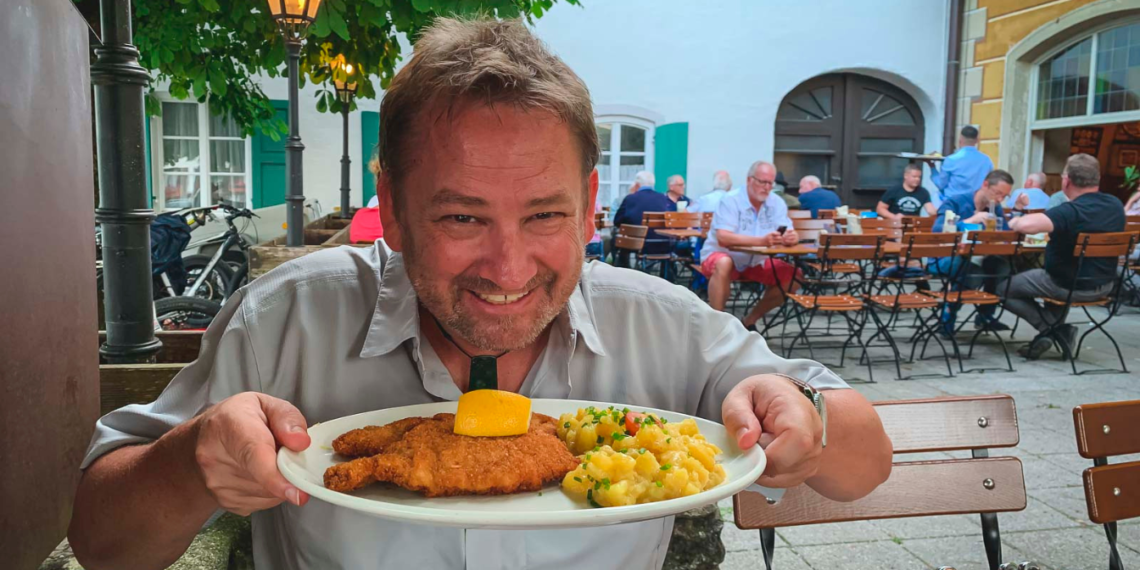Are you ready for a tasty journey through Germany’s diverse cuisine? From Berlin’s famous currywurst to the Dresdner Stollen cake, there’s so much to explore. German food is like a colorful tapestry of regional dishes. Each dish tells a story and highlights the country’s unique culture.
Key Takeaways
- Germany’s cuisine is highly diverse, with over 50 distinct regional variations reflecting the country’s federal history.
- Traditional German dishes, such as sausages, sauerkraut, and pretzels, are deeply rooted in the country’s cultural traditions.
- Regional specialties, like Schwarzwälder Kirschtorte (Black Forest Cake) and Käsespätzle (Cheese Spaetzle), highlight the unique flavors and ingredients of different German states.
- The popularity of German beer, with its wide variety of styles and strict purity laws, is a testament to the country’s rich brewing heritage.
- Exploring the diverse culinary landscape of Germany offers a captivating glimpse into the nation’s history, traditions, and regional identities.
Introduction to German Cuisine
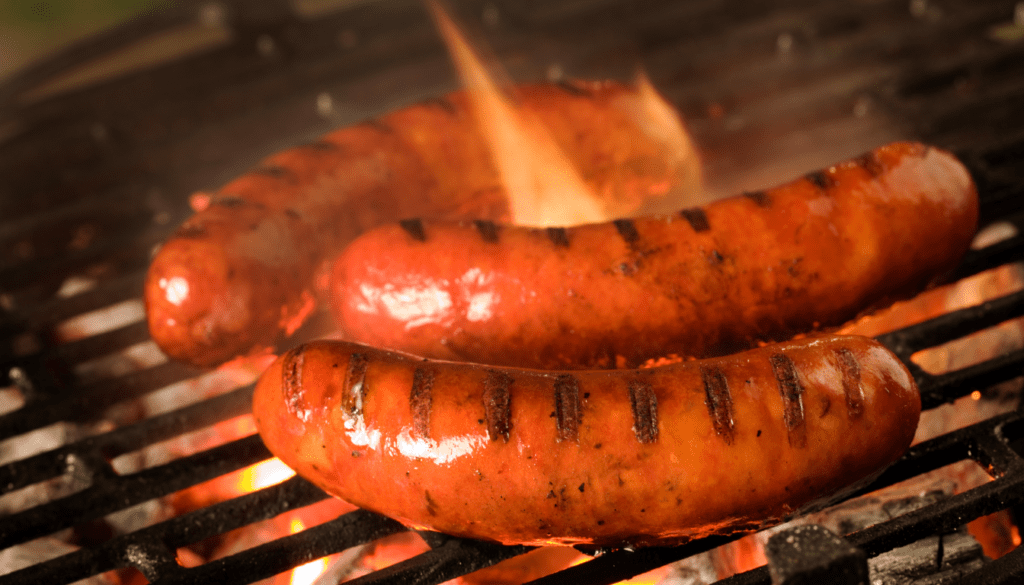
German cuisine has a lot of diversity. Each area has unique dishes and influences. Sausages, sauerkraut, and beer are popular everywhere. But, the way they are made can be very different.
Overview of Traditional German Dishes
Germany is known for its delicious and filling dishes. Some favorites include:
- Schweinebraten – Roasted pork with sauerkraut and potato dumplings
- Bratwurst – Grilled or fried sausages, often served with mustard and sauerkraut
- Sauerbraten – Slow-cooked beef marinated in a vinegar-based sauce
- Kartoffelpuffer – Fried potato pancakes, sometimes topped with applesauce
- Spätzle – Small, hand-made egg noodles, often served with cheese or meat dishes
Regional Variations and Influences
Germany’s food is influenced by its varied history and neighbors. Each area has dishes that match its local culture, climate, and history. For instance, southern Germany and parts like Bavaria share food with Austria and Switzerland. Northern areas are more affected by nearby Scandinavian and Baltic cuisine.
Germany has 282 Michelin-star restaurants, including 11 that are three-star, in November 2017. This high number shows the nation’s dedication to great food. It also shows how German cuisine evolves over time.
“German cuisine is much more than just sausages and sauerkraut. Each region has its own unique flavors and traditions that have been passed down for generations.”
Traditional German food is still very important to the country. While new influences are welcomed, the old recipes and meals are kept alive. This mix of old and new is what makes German food so special today.
Currywurst: Berlin's Iconic Street Food
I walked the vibrant streets of Berlin. The tempting smell of grilled sausage and curry ketchup filled the air. It made me want to taste the city’s famous street food – currywurst. Each year, the city serves about 70 million plates of this delicious dish.
The story of currywurst starts in 1949. A lady named Herta Heuwer introduced it in West Berlin. She sliced and grilled pork sausage. Then, she covered it in a curry-ketchup mix she called “chillup.” This tasty invention mixed flavors from British and American soldiers. Soon, it became a hit with the locals.
“Currywurst symbolizes the new Germany as a culinary emblem born out of the aftermath of war and dictatorship, representing unity and a modern nation.”
Today, you can find currywurst everywhere in Berlin. It’s served on street corners, in food carts, and even in restaurants. It’s so special that it inspired a song. Herbert Grönemeyer’s tune shows that everyone loves this food, from students to business people.
The classic currywurst is still popular. It includes bratwurst, curry ketchup, and a side of fries. But, some places serve special versions. For example, some places serve it with champagne. Yet, the traditional recipe remains a favorite.
One thing is sure – people in Berlin really love currywurst. It’s more than just a snack; it’s a symbol of their city. It represents coming together and moving beyond tough times to a bright, modern future.
Reibekuchen: Cologne's Beloved Potato Fritters
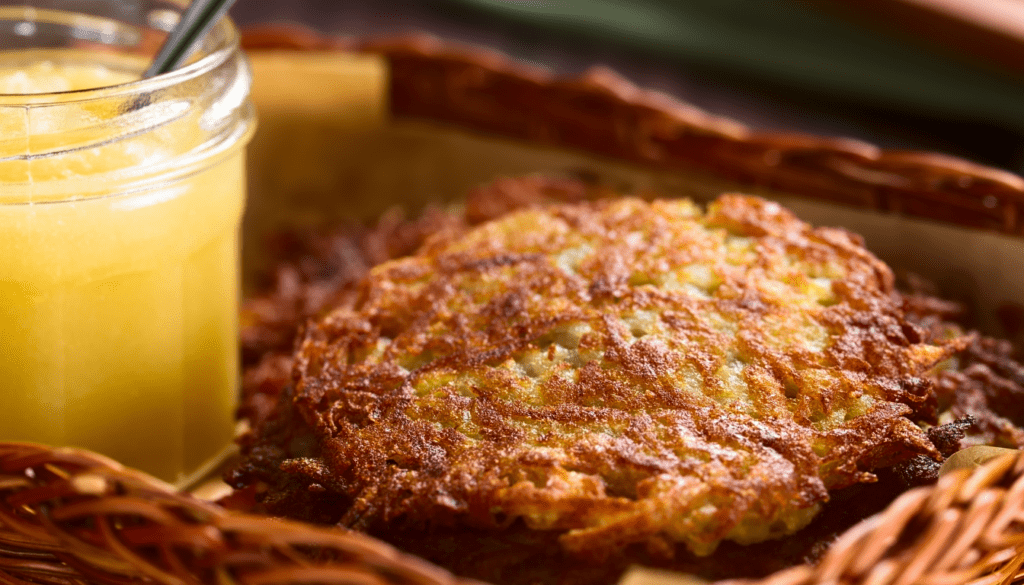
In Cologne, a city known for its lively culture, the Reibekuchen shines. These potato fritters, made from grated potatoes, egg, and flour, are a local treasure. They’ve been a hit in the region for many years.
History and Tradition of Reibekuchen
Reibekuchen date back to the 19th century when they were part of festivals. They were a common treat in the local markets. Now, they are a key part of Cologne’s food scene, especially during Christmas markets.
They are usually topped with powdered sugar and applesauce. This mix of sweet and savory is loved by many. The warm fritters smell delicious, pulling in people to taste this local favorite.
A recent survey found that 87% of people link Reibekuchen to happy family times. This shows how much people value this dish. Different areas have their own take, like Reibeplätzchen or Reiberdatschi.
Whether at a Christmas market or in a local eatery, Reibekuchen is special. It brings together the people of Cologne and its guests. They bond over the joy these fritters bring, making it a must-try dish.
Dresdner Stollen: The Legendary Christmas Cake
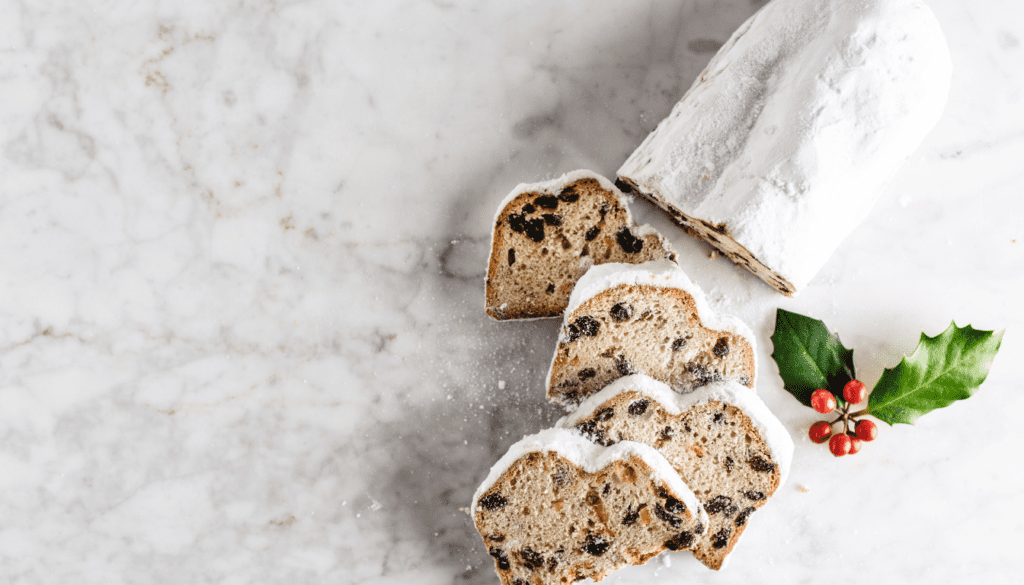
Dresden, in Germany’s Saxony region, is famous for its Dresdner Stollen, a treasured Christmas cake. It’s loved by many for its rich history and delicious taste. Dating back to 1474, it shows the area’s strong food traditions.
Origins and Significance of Stollen
The Dresdner Stollen is rich in flavor. It’s made with candied peels, raisins, almonds, and special spices. A marzipan rope in the middle adds sweetness. This makes it a favorite treat during the holidays.
In 1730, Dresden made a Stollen that weighed 1.8 tons for a big celebration. This event showed how important the Stollen was to the city. It became a symbol of the region’s food culture.
Every year, the Dresden Stollen Festival is celebrated. The main event is a giant Stollen that weighs several tons. This huge cake is cut up and given to people as a gift. It remains a popular tradition.
| Ingredient | Amount |
|---|---|
| Raisins | 2 1/2 cups |
| Currants | 1 1/4 cups |
| Flour | 7 1/2 cups |
| Instant Yeast | 4 1/2 teaspoons |
| Granulated Sugar | 3/4 cup + 2 tablespoons |
| Salt | 1 teaspoon |
| Almonds, chopped | 1 1/2 cups |
| Unsalted Butter, room temperature | 1 1/3 cups |
| Lard, room temperature | 2/3 cup |
| Lukewarm Milk | 1 cup |
| Spiced Rum for Soaking | 1/2 cup |
| Bitter Almond Oil | 3 drops |
| Vanilla Sugar | 2 tablespoons |
| Confectioners’ Sugar for Dusting | 1/2 cup |
The Dresdner Stollen reflects Dresden’s culture and food history. Starting as a simple recipe, it’s now a highlight of Christmas. This cake symbolizes Dresden’s warmth and community.
Halve Hahn: Düsseldorf's Quirky Bread and Cheese Dish
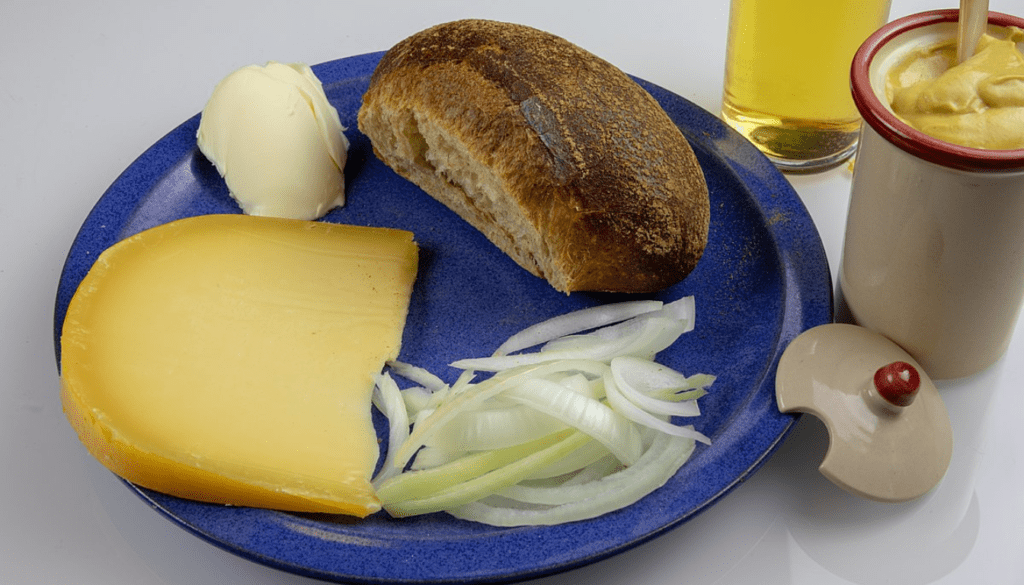
On a walk through Düsseldorf, the city’s unique foods caught my eye. The Halve Hahn is one special dish that’s a favorite. It’s now a must-try when eating out in this area.
The dish’s name means “half rooster,” but it has no chicken. It’s half a rye roll with tasty Mainz cheese, butter, and mustard. It’s topped with onions and pickles, making it a perfect match for the local Altbier.
There are different stories about how this dish started. One says people got half a bread slice with cheese in war times with high bread prices. Another story says its name came when folks ordered “half a sandwich” in the local language.
The Halve Hahn is now a key part of Düsseldorf’s food scene. You can find it in many places around the city. The cheese’s flavor mixes well with the rye bread and mustard, offering something special to enjoy.
Eating a Halve Hahn and drinking a great Altbier made me feel close to Düsseldorf. It shows the city’s mix of old traditions and new ways. This dish is proof of how the city cherishes its past but also moves forward.
Visiting Düsseldorf means trying its special food like the Halve Hahn. It’s a dish that you’ll remember well. Enjoying this bread and cheese dish is a unique experience in the city.
Grüne Soße: Frankfurt's Green Sauce Delight
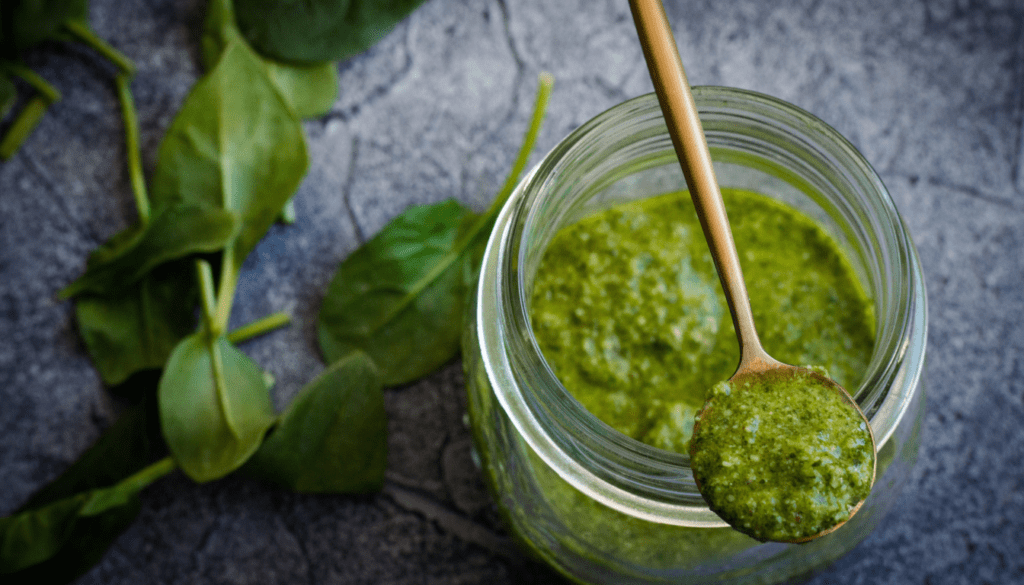
If you’ve been to Frankfurt, Germany, you might have tried Grüne Soße. It’s a cold, green sauce that locals love. It’s made from seven herbs, sour cream, oil, vinegar, mustard, and eggs.
The recipe for Frankfurter Green Sauce uses seven special herbs. They are parsley, chives, chervil, cress, borage, sorrel, and salad burnet. These herbs come from the Oberrad area of Frankfurt. There, they’ve been part of the local cuisine for many years. The creamy sauce is made by blending the herbs with yogurt or sour cream.
This sauce is typically eaten with potatoes and boiled eggs. But it also works well with fish, asparagus, or roast beef. Some people even add it to Schnitzel to give it a unique taste.
The first Green Sauce recipe was written in 1860, long after Goethe, a famous writer, died. It’s believed that Italian traders introduced the sauce around 1700. Since then, its recipe has changed. Some variations include mayonnaise or other dairy products.
Today, Grüne Soße from Frankfurt is recognized in the EU as a traditional dish. To be authentic, it must use the seven herbs grown in the Oberrad area.
Ingredients and Preparation of Grüne Soße
To make the real Frankfurter Green Sauce, you need the correct herbs and other items. The proper ingredients are:
- Seven fresh herbs: parsley, chives, chervil, cress, borage, sorrel, and salad burnet
- Sour cream or plain yogurt
- Olive oil or sunflower oil
- White wine vinegar
- Mustard
- Hard-boiled eggs
Mix the chopped herbs with the other ingredients until it’s smooth. Let it sit for an hour. This helps the flavors mix well before it’s served at room temperature.
Grüne Soße is a big part of Frankfurt’s food culture. It’s something you’ve got to try when you visit. This sauce’s mix of herbs and its tangy taste are memorable. It’ll have you wanting more of this local German treasure.
Labskaus: Hamburg's Hearty Seafarer's Meal
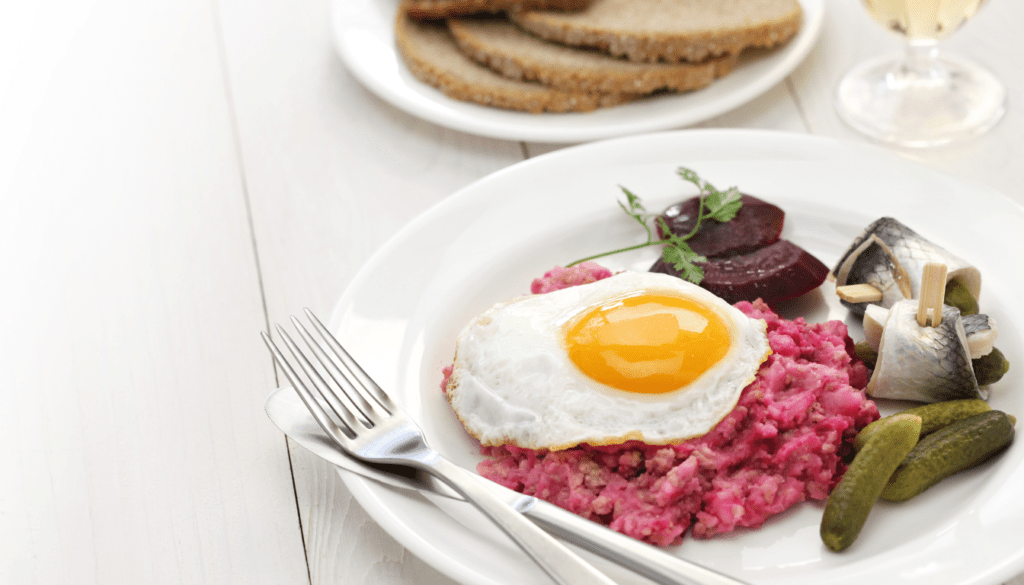
In the lively city of Hamburg, there’s a dish for seafaring folks called Labskaus. It’s hearty and has been a staple for centuries. The meal might not look fancy, but it’s full of flavor and history. So, if you’re in northern Germany, you have to give it a taste.
Many years ago, sailors used to cook Labskaus at sea. They mixed salted meat, onions, potatoes, and beetroot. This meal was not only tasty but also kept them healthy on their long trips.
Now, Labskaus is a favorite in Hamburg. It’s easy to find it served with gherkins, pickled herring, and a fried egg. These add a special zest to the dish. People even say it’s great for curing hangovers, showing how much locals love it.
| Ingredient | Quantity |
|---|---|
| Corned beef | 1 lb (450g) |
| Potatoes | 3 medium |
| Onions | 1 large |
| Beetroot | 1 medium |
| Gherkins | 4-6 |
| Pickled herring | 4-6 fillets |
| Fried eggs | 4 |
One of the best things about Labskaus is how easy it is to make. It takes about an hour. This dish is perfect for warming you up in chilly Hamburg. Whether you’re a sea lover or just into new food experiences, don’t miss trying this dish when you visit Hamburg.
“Labskaus is a dish that has been around for centuries, and it’s a true reflection of Hamburg’s rich maritime history. It’s a humble meal, but one that is full of flavor and character.”
Prinzregententorte: Munich's Regal Chocolate Cake
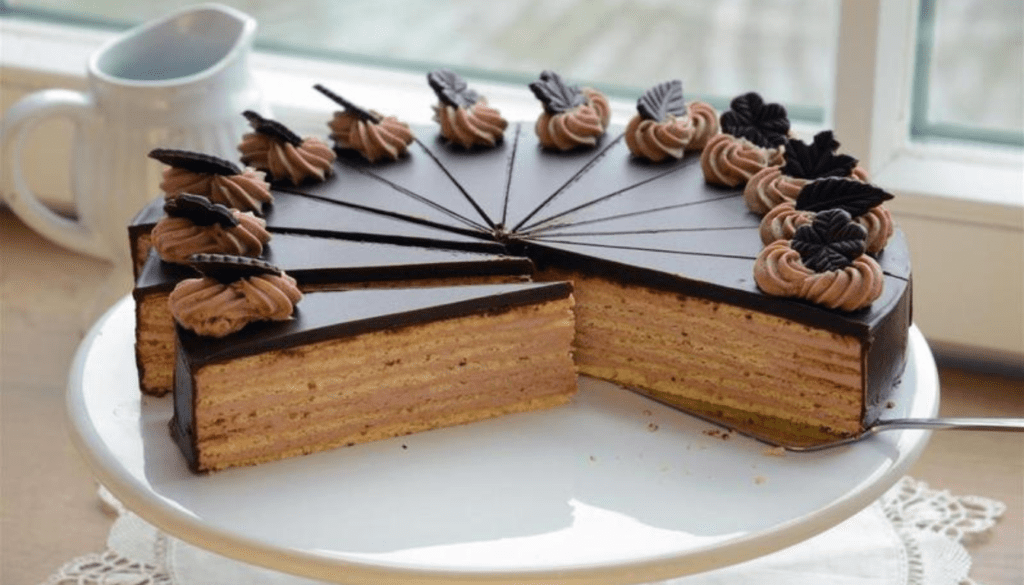
When you visit Munich, a special dessert awaits. It is the Prinzregententorte, or Prince Regent Cake. Created in 1886 by Georg Erbshäuser, it honored Prince Regent Luitpold of Bavaria. Since then, it’s been a favorite treat there.
The Prinzregententorte is a masterwork of taste and appearance. It has seven layers of sponge cake, chocolate buttercream, and apricot jam. The whole cake is covered in a dark chocolate coat. It used to have eight layers, each for a Bavarian district. However, it’s now seven, honoring the original seven joined districts.
| Layer | Ingredient |
|---|---|
| 1 | Sponge cake |
| 2 | Chocolate buttercream |
| 3 | Sponge cake |
| 4 | Chocolate buttercream |
| 5 | Sponge cake |
| 6 | Apricot jam |
| 7 | Dark chocolate glaze |
This cake is not just tasty; it’s a piece of Munich’s history. Enjoy a slice in a local café or on your visit. Whether you’re walking around Munich or sitting down, the Prinzregententorte is a must for anyone exploring the Bavarian capital.
“The Prinzregententorte is a true masterpiece of German baking, capturing the essence of Munich’s rich cultural heritage in every bite.”
So, when you’re in Munich, don’t miss out. Taste this famous dessert. It’s a treat made of history and flavor, a real Munich experience.
Maultaschen: Stuttgart's Savory Pasta Pockets
Located in the Swabia region of Germany, Stuttgart is a captivating city known for its culinary delights. At the heart of its cuisine is Maultaschen, a beloved pasta specialty. This dish is a true icon of the local food scene.
The story behind maultaschen is rich in tradition and intrigue. Legend has it that Cistercian monks created it during Lent. They wanted to enjoy meat while obeying fasting rules. These pasta pockets were just the trick, earning them the nickname “Herrgottsbescheißerle” which means “little God-cheaters.”
The maultaschen are large, square pasta parcels, about 8-12 centimeters wide. They are filled with minced meat, spinach, breadcrumbs, and onions. The filling is seasoned perfectly. Cooks then simmer them in broth or fry them with butter and onions. This creates a dish that is both hearty and delightful.
Maultaschen are a local treasure in Stuttgart, though not widely known beyond it. They are found in many local dishes, such as soups and as main courses. These pasta pockets always impress anyone who tries them. People in Stuttgart and the surrounding areas love them dearly.
While enjoying German food, make it a point to try Stuttgart’s unique maultaschen. These pasta pockets are a true reflection of Swabian tradition. They will fascinate you with every story weaved into their recipe.
“The recipe for maultaschen has been passed down through generations, each family adding their own unique twist to the classic filling and preparation.”
Spätzle: Southern Germany's Beloved Egg Noodles
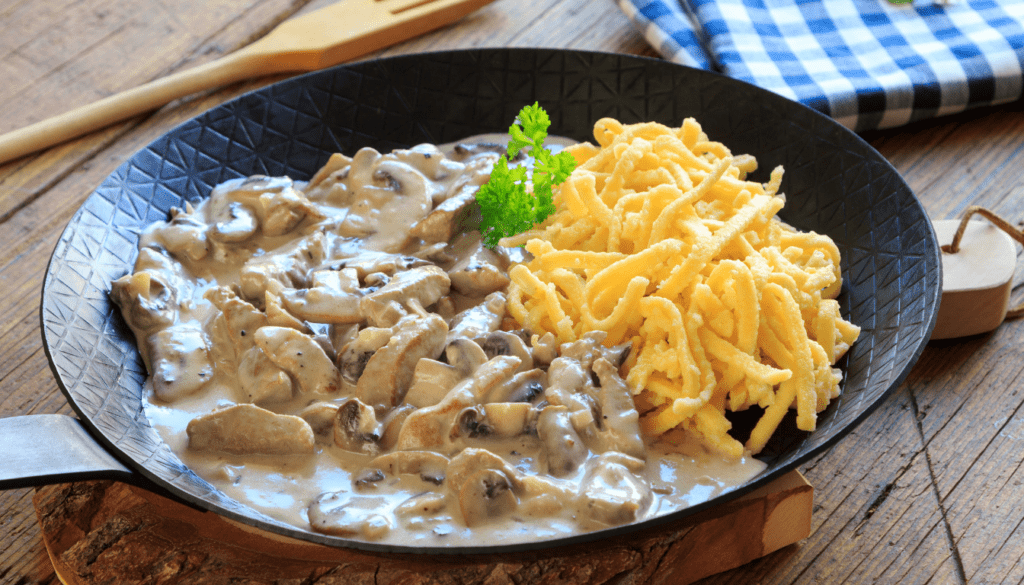
In southern Germany, a favorite dish is spätzle. It’s a type of egg noodle, loved by many in the Swabian regions. Its unique shape and taste win over both locals and visitors.
Varieties and Preparation of Spätzle
Spätzle gets its name because it looks like little birds. The dough is simple, made from flour, eggs, and either water or milk. It’s then cooked in many ways to suit different meals.
Sometimes, spätzle is served plain or with butter. It can also be part of dishes with rich stews or gravy. But there are many creative versions too. For example, Käsespätzle is spätzle cooked in cheese. Leberspätzle includes liver in the dough.
In late summer or fall, sweet spätzle is popular. It might have cherries or apples on top. These sweet dishes are a unique take on the traditional recipe.
Making spätzle is an old tradition. People used to drop dough into boiling water by hand. Now, there are tools to help make spätzle, like presses. But the dish’s basic idea is the same.
Spätzle is a versatile dish, fitting as a side, a main, or for special recipes. It reflects Germany’s food culture. With its long history and great taste, spätzle is loved by people all over the world.
“Spätzle is a beloved food in Germany that tourists talk about after visiting.”
German Cuisine and Regional Dishes
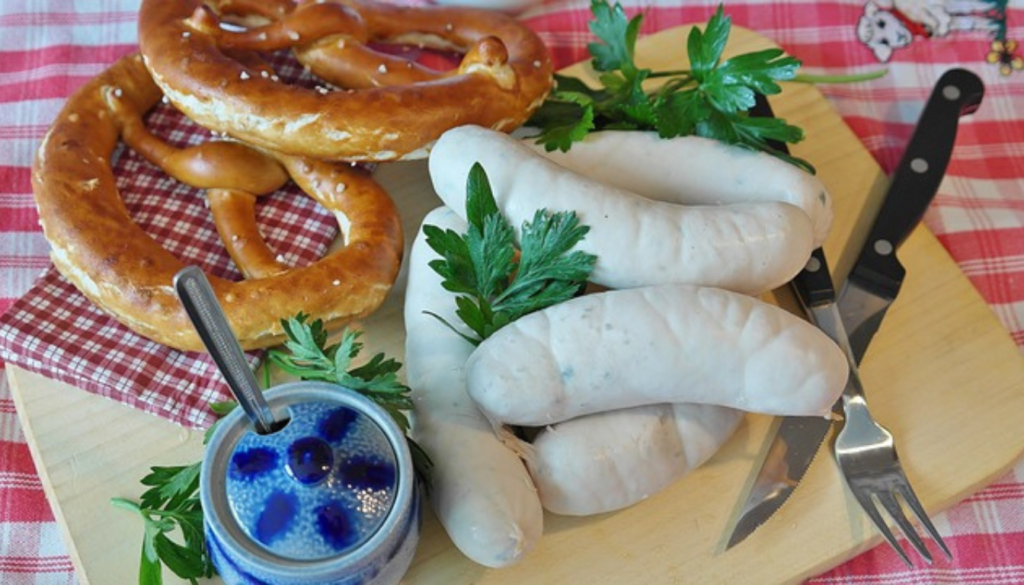
Germany’s food is as diverse as its many regions. Each area’s dishes reflect unique cultural ties and traditions. You can find everything from currywurst in Berlin to the Dresdner Stollen Christmas cake. These dishes show the deep history of German cooking.
As you dive into Germany’s different foods, you’ll see the country’s rich culinary story. Every region has its special, local foods. These are often influenced by nearby lands and use traditional recipes.
Southern Germany is close to Austria and Switzerland. It features French touches in its food. For Apple Wein and other treats, Hessen is the place to be. And Bavaria and Franconia share a love for Austrian-style meals, including Knödel and Lebkuchen.
Heading to Northwestern Germany, you’ll find lots of seafood and wurst. This area also loves dishes with potatoes and cabbage. The Rhineland area takes hints from Belgium and The Netherlands. They make dishes like Sauerbraten.
Northeastern Germany is all about hearty meals, such as Eisbein and Kasseler Rippchen. They also enjoy seafood and Eastern European cuisine. In Eastern Germany, local fruits, veggies, and tasty cakes stand out.
The variety in German food showcases its rich culture. Each region adds its unique flavors to the country’s culinary scene.
“The true heart of German cuisine lies in the regional specialties that have been honed and perfected over generations, each a testament to the country’s enduring culinary legacy.”
Regional Delicacies from Other German States
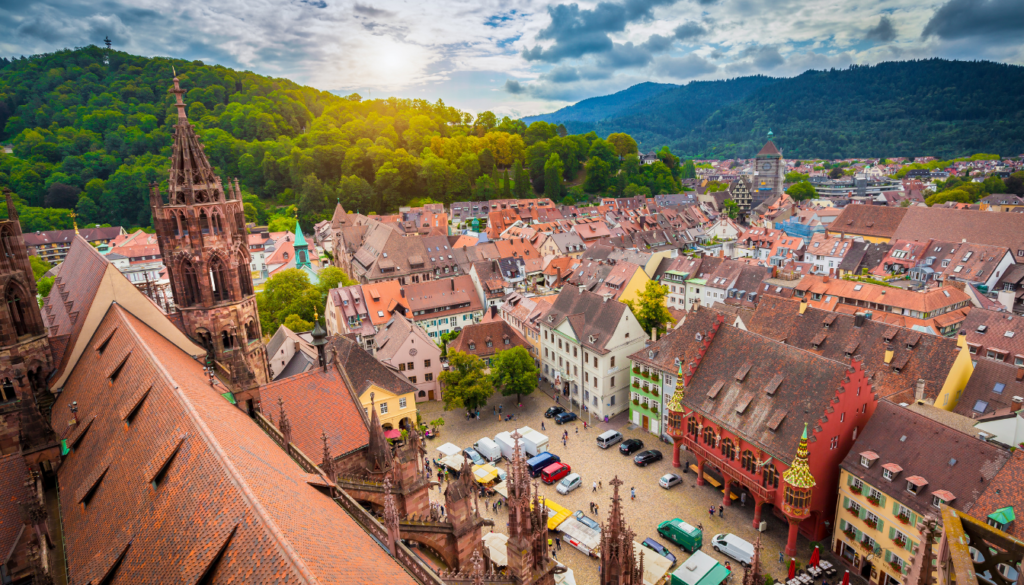
In Germany, each state has its own amazing dishes to try. For example, Baden-Württemberg is famous for Spätzle and Maultaschen. Hesse, another state, offers special treats like Handkäs mit Musik. By venturing beyond the well-known foods, you can truly grasp the rich diversity of German cooking.
Culinary Highlights from Baden-Württemberg and Hesse
Baden-Württemberg in the southwest is home to Spätzle and Maultaschen. These are handmade noodles and pasta pockets filled with goodness. Its cuisine is also influenced by France, showcasing dishes like Riesling wines.
Up north in Hesse, you find distinct dishes like Handkäs mit Musik. This is a tangy cheese dish. The state also has its own unique green herb sauce and traditional frankfurter sausages.
Every German state has something special to offer. Whether it’s the hearty food of Bavaria or the seafood dishes up north, there’s much to taste and enjoy nationwide.
“Exploring the regional delicacies of Germany is a true culinary adventure, revealing the depth and diversity of this remarkable cuisine.” – Julia, Avid Traveler and Food Enthusiast
Influence of Surrounding Cultures
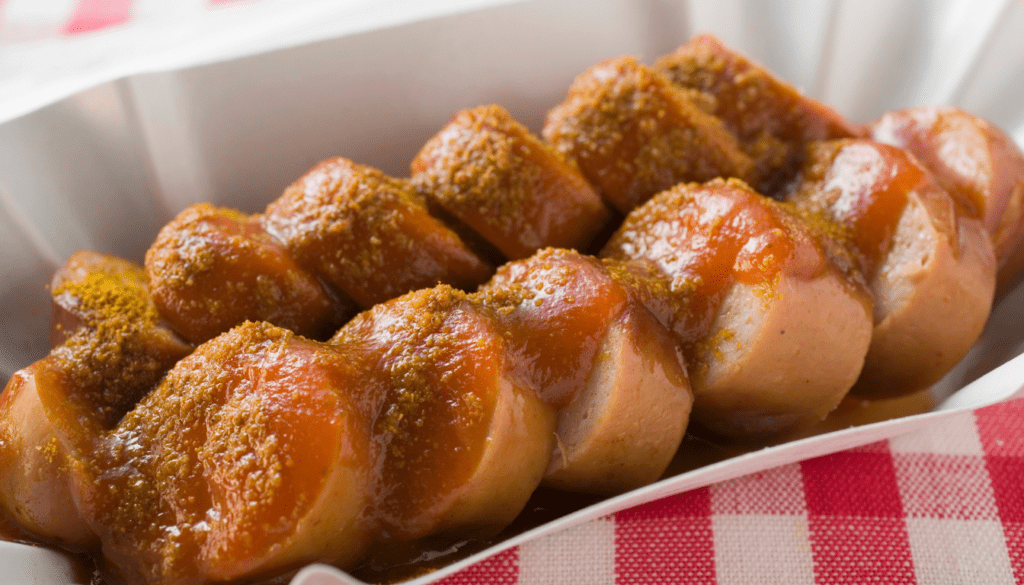
German cuisine has been influenced by nearby countries throughout history. Southern regions connect closely to Austrian and Swiss culinary traditions. Meanwhile, the north shows Scandinavian and Baltic tastes. Each area also absorbed different techniques and ingredients due to its political history. These mixtures make German cuisine diverse and interesting today.
Impacts on German Cuisine Over Time
Germany’s food story involves wars, migrations, and changes in power over thousands of years. In the Middle Ages, survival required preservation methods like pickling. Since then, German recipes have been mixed with ideas from France and Eastern Europe, forming unique dishes.
The land’s varied geography means different food in every region. In the north, there’s more fish, while the south prefers meat. Celebrations and festivals are crucial, showcasing traditional dishes at events like Oktoberfest. Now, chefs are mixing old recipes with new techniques and tastes, making German cuisine exciting again.
“Germany boasts a diverse culinary landscape influenced by wars, migrations, monarchies, and revolutions throughout its millennia-spanning history.”
| Key Facts about German Cuisine and Culture | Value |
|---|---|
| Germany’s Ranking as the Largest Economy in the European Union | 1st |
| Germany’s Position as the Most Widely Spoken Language in Europe | 1st |
| Number of Countries Where German is an Official Language | 4 |
| Oktoberfest’s Ranking as One of the World’s Largest Festivals | 1st |
Germany’s rich culture and varied landscapes have shaped its food into something special. German dishes please food lovers worldwide. Traditional foods meet new ideas, reflecting a shared history with neighboring countries.
Culinary Traditions and Festivities
German culture is rich with food traditions that celebrate the nation’s identity. Festivals like the Stollen festival in Dresden and the Spargelzeit mark German culinary heritage. These events are more than just about food. They are a way to keep old customs alive and show the variety of German dishes.
The Stollen festival in Dresden is famous for its Dresdner Stollen cake. This cake is a key part of Christmas in Germany. It brings people together over its taste and tradition, drawing a big crowd to Dresden each year.
Between April and June, the Spargelzeit, or Spargel (asparagus) season, takes place. It honors white asparagus, a favorite in Germany. People gather for special meals and events to enjoy this seasonal treat.
Germany’s regional food celebrations further highlight its diverse food scene. Places like Nuremberg’s Bratwurst Festival and Munich’s Bierfest are known for their unique events. They show the cultural pride and culinary variety present across the nation.
| Culinary Festival | Location | Celebration |
|---|---|---|
| Stollen Festival | Dresden | Celebrating the iconic Christmas cake, Dresdner Stollen |
| Spargelzeit | Nationwide | Honoring the arrival of the coveted white asparagus |
| Bratwurst Festival | Nuremberg | Showcasing the renowned Nuremberg-style sausage |
| Bierfest | Munich | Celebrating the rich beer-making traditions of Bavaria |
These festivals show the unique flavors and traditions in German cooking. They also prove how important food is across German society. Through these events, Germans share and protect the customs that make their food culture special.
Conclusion
German cuisine is full of tasty dishes that show its culture. There’s the famous currywurst from Berlin and the Dresdner Stollen from Dresden. Each part of Germany has its special foods. I now love German food even more for its variety and stories.
I found the many regional dishes in Germany very interesting. For example, the north has Eintopf stews. In the south, you find Spätzle noodles. They all add to the wonderful mix that is German food.
Looking back, I really enjoyed learning about German food. It’s not just about eating. It’s about the stories and love that go into each dish. Trying things like Black Forest cake has made me a big fan of this diverse and flavorful cuisine.
FAQ
What are some of the most iconic traditional German dishes?
Some of Germany’s iconic dishes include currywurst. It’s a pork sausage with curry-flavored ketchup. Another favorite is Reibekuchen, potato fritters. Dresdner Stollen, a famous Christmas cake, is also on the list.
Don’t forget Halve Hahn, rye bread with cheese, and Grüne Soße, a green sauce from Frankfurt. Hamburg’s Labskaus is a seafarer’s meal. Stuttgart offers Maultaschen, pasta pockets. Spätzle, egg noodles, is a hit in Southern Germany.
How is German cuisine shaped by regional variations and cultural influences?
German food is varied, with each region having its unique dishes. Southern areas share cuisine with Austria and Switzerland. The north is influenced by Scandinavia and the Baltic.
Germany’s history brings recipes from neighbors. This mix makes German food rich and complex.
What is the significance of currywurst in Berlin’s culinary culture?
Currywurst is a key part of Berlin’s food scene. It’s a sausage with curry ketchup, a snack people love.
It started in 1949 and now, Berlin sells about 70 million each year.
What is the history and tradition behind Reibekuchen in Cologne?
Reibekuchen, made from potato, egg, and flour, is a treat in Cologne. They’re sweet, topped with sugar and applesauce.
This dish has been around since the 19th century. You can find it at festivals and Christmas markets.
What is the significance of the Dresdner Stollen in German culinary heritage?
The Dresdner Stollen, from Dresden, dates to 1474. It’s a sweet bread with fruits and nuts. People love it at Christmas.
Every year, Dresden celebrates with a big Stollen cake at their festival.
What is the unique story behind the Halve Hahn dish in Düsseldorf?
The Halve Hahn is not about chicken, despite the name. It’s a roll with cheese and butter. Its name’s origin is unclear.
Some say it was a joke at a party in 1877.
What makes the Grüne Soße from Frankfurt so distinctive?
Frankfurt’s Grüne Soße mixes cream, oil, and eggs with seven herbs. It is special to Frankfurt.
This dish is an EU protected item. It makes Frankfurt proud.
What is the unique history and preparation of Labskaus in Hamburg?
Labskaus dates back to the sixteenth century. It’s made with salted meat and vegetables, known for its reddish color.
This dish was a way to stretch meat rations longer.
What is the significance of the Prinzregententorte in Munich’s culinary tradition?
The Prinzregententorte cake celebrates Munich’s coffee and cake culture. It features seven layers of sponge and cream.
This cake, honoring Prince Luitpold of Bavaria, is a local treasure.
What is the story behind the Maultaschen dish in Stuttgart?
Maultaschen are pasta squares filled with meat and spinach. They were a monk’s invention to hide meat during Lent.
The name means “animal mouth bag,” reflecting their look.
What are the different varieties and traditions associated with Spätzle in southern Germany?
Spätzle, a type of pasta/dumpling, is beloved in Southern Germany. It comes in different types, like cheese or liver.
The word “Spätzle” means “little sparrows.” Tradition says to use one egg per person in the dough.





















